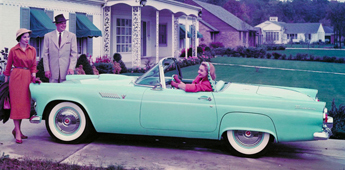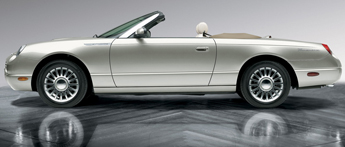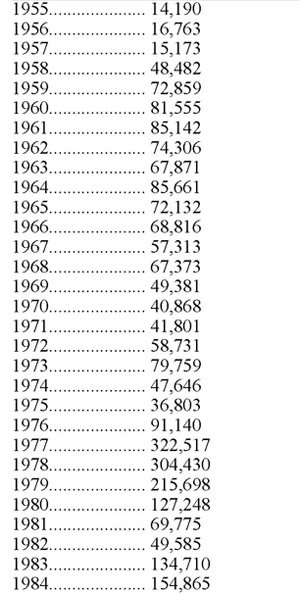|
|
|
|
|
A Cherished Roadster It was an unusual car with a molded fiberglass tonneau and padded headrests that transformed the four-seat convertible into a two-seater car. Special features included wire wheels with chrome-plated spokes and rims, simulated knock-off hub caps and an assist bar for passenger comfort during cornering. Interestingly, the roadster had a special emblem - a gull-like bird, not a Thunderbird - superimposed over a red, white and blue crest that was mounted on the front fenders below the Thunderbird script. The base roadster retail price was $5,439. Some fully equipped models sold for more than $7,000. After two years and a total production of 1,882, the sports roadster was discontinued. The 1964 Thunderbird With the bumper and grille designed to provide a faster, more aerodynamic look, the overall styling continued Thunderbird's by-now traditional image of "swift-lined sleekness." Interior design also reflected the space-age styling of the early and mid-1960s. Featured were luxuriously padded, high, thin shell, contoured individual seats, "pistol grip" door handles and a full-width, safety-padded instrument panel. Radio, clock and retractable seat belts also were standard. New options included individual reclining seats and trailer towing equipment. And, insulation and sound-proofing were improved to the point that they were described as "super." Though the design for the 4,760-pound car was essentially the same as 1964-65 models, the 1966 Thunderbird became a collector's favorite because it is regarded as the best of the four-seaters of the era. The 1966 edition offered Town Hardtop and Town Landau models with a unique appearance gained from a bold new roof line extending forward into the quarter area of the door windows and without the conventional quarter windows. Windshield washers and vacuum door locks were added to the standard equipment, and power six-way seats and a power antenna were new options. All Thunderbird convertibles, but especially the 1966 convertibles, are collectors' items. The reasons are obvious: First, they are Thunderbirds, second, they are convertibles. Ford discontinued the Thunderbird convertible after the 1966 model year. Not counting the two-seaters, 70,234 were produced. The 1967 Thunderbird The front-end highlight was a crisp lattice-work grille deeply inset and outlined with thin, bright metal moldings on the top and sides. The grille was framed at the bottom by a new deep-sectioned bumper that blended into the sheet metal, and the headlights were concealed by doors at the outboard edges of the grille. Inside were newly sculptured twin bucket seats, a full-length console, all-vinyl door panels with full-length arm rests trimmed in bright metal, and the all-new Tilt-Away steering wheel - an exceptionally popular Thunderbird comfort/convenience feature. Also, for the 1967-model year, a four-door model was added. It was discontinued after the 1969-model year. The four-door didn't help sales much - only 70,988 were built during the two years it was on the market - but today they are collectors' cars and are rapidly gaining in value. From 1967-69, a four-door model was produced and rapidly gaining value in the collectors' market. Into the '70s The 1970 Thunderbird introduced new styling featuring a long hood treatment and a unique bumper/grille treatment that made the bumper almost invisible. Other exterior design features included a new extruded-aluminum grille (the "poke-thru nose") flanked by dual headlights. A concealed radio antenna provided a non-cluttered look and eliminated antenna noise. Concealed windshield wipers and cowl air vents provided a clean, "sweeping" line from the hood to the roof, and back-up lights were "concealed" in the center rear panel. Ultra-luxurious appointments were on the inside. Included were a standard full-width front bench seat with attractive, re-designed head restraints, individual bucket-style seat backs and a fold-down center armrest. Thick padded armrests extended the full-length of the front door panels. Safety innovations included a "Uni-Lock" three-point safety-belt and shoulder harness system. The powertrain for the 4,551-pound car was the 429 V-8 engine and Ford's Select-Shift Cruise-O-Matic transmission. HisandHer Thunderbirds A New Generation of Luxury The 1972 Thunderbird was on a 120.4 wheelbase (5.4 inches longer) and overall length was 216 inches. The car weighed 4,596 pounds. Strikingly handsome and formal in appearance, it achieved new levels of luxury and comfort, even for the Thunderbird. Michelin radial-ply steel-belted tires and bodyside protection molding were standard. The standard power front disc brakes were re-designed to provide more positive braking and longer brake life than previous systems. The number of parts in the all-new braking system was reduced from 26 to 12 for even greater reliability and quicker service. The Sure-Track Brake Control System was added as optional equipment. The Epitome of Personal Luxury The added length was to accommodate Ford's most powerful engine, the 460 CID V-8, and much of the added weight was accounted for by the addition of air conditioning - and the bigger engine - as standard equipment. Other standard refinements were concealed windshield wipers, a distinctive opera window, dense-grain vinyl roof, solid-state ignition, power side windows, automatic seat-back release, spare tire lock and white sidewall, steel-belted, radial tires. Available for the first time were power four-wheel disc brakes, making Thunderbird one of the few American-built cars to offer this safety-enhancing feature. The four-wheel disc brakes were more consistent when hot or wet and stopped the vehicle in shorter distances than conventional front disc/rear drum braking systems. Other options were power mini-vent windows, quick-defrost windshield and rear window and moon roof. With the exception of three new luxury groups, the 1976 Thunderbird was basically the same as the 1975 version in terms of luxury, convenience, appearance and standard equipment levels. New as optional equipment were a power lumbar seat and an AM/FM quadrasonic eight-track tape player. The greatest significance of the 1976 Thunderbird was that it marked the end of another Thunderbird era. After this, the flight of the Thunderbird would change directions. New Directions Built on a 114-inch wheelbase, it was a slimmer and sleeker automobile that retained many of the traditional Thunderbird styling touches that millions of owners and admirers had come to know. The appearance of the 1977 Thunderbird was spotlighted by a unique wrapover roof treatment, featuring beveled glass opera windows in the center pillars. Other distinctive features included a chrome-plated grille, hidden headlamps and "wall-to-wall" taillamps.
Into the '80s and '90s
In 1983, Ford took Thunderbird into a new design phase introducing the "aero-style" Thunderbird that would lead Ford Motor Company and the industry in a new direction. The bold styling would next find its way into the car that changed the industry for years to come beginning in 1986 - the Ford Taurus. Thunderbird was all-new from the ground up in 1989, featuring an exterior design destined to further reshape the aero-styling trends of the '80s. It was a leader in technology transfer from racing to production and was among the first vehicles outfitted with Ford's next generation electronic engine control module developed by Ford's Formula One racing program.
On Jan. 3, 1999, Nasser unveiled a new two-seat Thunderbird concept car at the 1999 North American International Auto Show in Detroit. In May 2000, Ford confirmed it would build a production version of the hit concept car as a 2002 model year thus the Thunderbird legend lived on into the new millennium.
The 2002-2005 Thunderbird The Rebirth The Golden Anniversary Special Thunderbirds In the spring of 2003, Ford sold 700 limited edition "007" Ford Thunderbirds to commemorate the first appearance of a Thunderbird in the 40-year history of the James Bond film franchise. A "007" Edition was driven in the Bond film Die Another Day by Academy Award-winning actress Halle Berry. One thousand Pacific Coast Roadster Thunderbirds were sold in 2004. The 2005 Ford Thunderbird continues to deliver a unique combination of classic American "relaxed sportiness," offering balanced performance with touring comfort. Still attracting a new generation of buyers, all 2005 edition Thunderbirds features a 50th anniversary commemorative fender chevron. The 2005 50th Anniversary Thunderbird Production of this special edition model with exclusive Cashmere color, which begins in January 2005, will be limited to 1,500 units. "The 50th Anniversary Limited Edition Thunderbird builds upon the car's rich heritage - which began with the classic, two-seater 1955 model," said Steve Lyons, president of Ford Division. "This special edition adds to the emotional attachment that America has with Thunderbird, an attachment that has been 50 years in the making." In addition to the 50th Anniversary Limited Edition, Ford is unveiling two surprise colors available on upcoming 2005 Thunderbirds: Inca Gold and Bronze. For 2005, all Thunderbirds feature a 50th Anniversary commemorative fender chevron. Based on the top-of-the-line Thunderbird premium, the commemorative 50th Anniversary Thunderbird features a gorgeous Cashmere tri-coat metallic paint with matching removable top and Medium Light Stone cloth convertible top and soft boot. 16-spoke, 17-inch wheels with Cashmere accented hub ring match the Cashmere paint. New coordinated Cashmere, Stone and Soft Gold interior packages include full leather Cashmere seats, and Cashmere trimmed lower instrument panel, floor console and door armrests. An understated Soft Gold tinted 50th Anniversary badge will be placed on the instrument panel, and 50th Anniversary insignias are embossed on the seatbacks. The scuff plates also are tinted Soft Gold. Each vehicle will feature a numbered commemorative plaque mounted on the inside of the glove box. The steering wheel and shift knob will be trimmed with high gloss Cashmere accents. Stone colored carpets with matching floor mats complete the interior. The 2005 Ford Thunderbird will have a manufacturer's suggested retail price of $37,605 and the special edition 50th Anniversary Thunderbird of $43,535, both without destination and delivery charges.
The 2003 "007" Edition Thunderbird The "007" edition will have a unique white leather interior and a distinctive Coral paint scheme to match the Thunderbird driven in the Bond film Die Another Day by actress Halle Berry. The Coral paint similar to the Sunset Coral hue offered on the 1956 Thunderbird and also matches the bikini Berry wears in her role as Jinx. 2003 Thunderbird "007" edition also will feature a number of performance enhancements, including:
The "007" Thunderbird will have a manufacturer's suggested retail price of approximately $43,000. The Limited Edition "007" Thunderbird stands out from other 2003 Thunderbirds with its Coral body finish and a Performance White removable top. Chrome 21-spoke, 17-inch wheels match the A-pillar and trim accents. A new Performance White interior package includes full leather solid white seats, and white-trimmed lower door panels and speaker covers. An understated "007" badge will be placed on the instrument panel, and Thunderbird insignias are located on the seat backs. Each vehicle also will feature a numbered commemorative plaque mounted on inside the glove box. The steering wheel and shift knob will be trimmed in Black Ink leather. The 2002 Neiman Marcus Edition Thunderbird
|
|
Home < Ford Group < Ford Cars < History
|






















